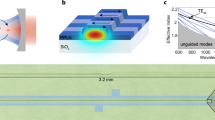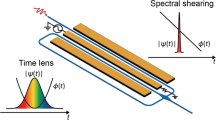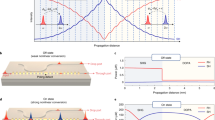Abstract
Although gigahertz-scale free-carrier modulators have been demonstrated in silicon, intensity modulators operating at terahertz speeds have not been reported because of silicon’s weak ultrafast nonlinearity. We have demonstrated intensity modulation of light with light in a silicon–polymer waveguide device, based on the all-optical Kerr effect—the ultrafast effect used in four-wave mixing. Direct measurements of time-domain intensity modulation are made at speeds of 10 GHz. We showed experimentally that the mechanism of this modulation is ultrafast through spectral measurements, and that intensity modulation at frequencies in excess of 1 THz can be obtained. By integrating optical polymers through evanescent coupling to silicon waveguides, we greatly increase the effective nonlinearity of the waveguide, allowing operation at continuous-wave power levels compatible with telecommunication systems. These devices are a first step in the development of large-scale integrated ultrafast optical logic in silicon, and are two orders of magnitude faster than previously reported silicon devices.
This is a preview of subscription content, access via your institution
Access options
Subscribe to this journal
Receive 12 print issues and online access
$259.00 per year
only $21.58 per issue
Buy this article
- Purchase on Springer Link
- Instant access to full article PDF
Prices may be subject to local taxes which are calculated during checkout




Similar content being viewed by others
References
Soljacic, M., Luo, C., Joannopoulos, J. D. & Fan, S. H. Nonlinear photonic crystal microdevices for optical integration. Opt. Lett. 28, 637–639 (2003).
Yablonovitch, E. Photonic crystals: semiconductors of light. Sci. Am. 285, 46–55 (2001).
Almeida, V. R., Barrios, C. A., Panepucci, R. R. & Lipson, M. All-optical control of light on a silicon chip. Nature 431, 1081–1084 (2004).
Lipson, M. Overcoming the limitations of microelectronics using Si nanophotonics: Solving the coupling, modulation and switching challenges. Nanotechnology 15, S622–S627 (2004).
Loncar, M., Doll, T., Vuckovic, J. & Scherer, A. Design and fabrication of silicon photonic crystal optical waveguides. J. Lightwave Technol. 18, 1402–1411 (2000).
Srinivasan, K., Barclay, P. E., Borselli, M. & Painter, O. Optical-fiber-based measurement of an ultrasmall volume high-Q photonic crystal microcavity. Phys. Rev. B 70, 081306(R) (2004).
Foresi, J. S. et al. Photonic-bandgap microcavities in optical waveguides. Nature 390, 143–145 (1997).
Barrios, C. A., Almeida, V. R. & Lipson, M. Low-power-consumption short-length and high-modulation-depth silicon electrooptic modulator. IEEE J. Lightwave Technol. 21, 1089–1098 (2003).
Almeida, V. R. & Lipson, M. Optical bistability on a silicon chip. Opt. Lett. 29, 2387–2389 (2004).
Liao, L. et al. High speed silicon Mach–Zehnder modulator. Opt. Express 13, 3129–3135 (2005).
Barclay, P. E., Srinivasan, K. & Painter, O. Nonlinear response of silicon photonic crystal microresonators excited via an integrated waveguide and fiber taper. Opt. Express 13, 801–820 (2005).
Xu, Q et al. Micrometre-scale silicon electro-optic modulator. Nature 435, 325–327 (2005).
Baehr-Jones, T. et al. Optical modulation and detection in slotted silicon waveguides. Opt. Express 13, 5216–5226 (2005).
Xu, Q., Almeida, V. R. & Lipson, M. Demonstration of high Raman gain in a submircometer-size silicon-on-insulator waveguide. Opt. Lett. 30, 35–37 (2005).
Boyraz, O. & Jalali, B. Demonstration of a silicon Raman laser. Opt. Express 12, 5269–5273 (2004).
Rong, H. et al. An all-silicon Raman laser. Nature 433, 292–294 (2005).
Jones, R. et al. Lossless optical modulation in a silicon waveguide using stimulated Raman scattering. Opt. Express 13, 1716–1723 (2005).
Marder, S. R. et al. Large molecular third-order optical nonlinearities in polarized carotenoids. Science 276, 1233–1236 (1997).
Brozozowski, L. & Sargent, E. H. Azobenzenes for photonic network applications: Third-order nonlinear optical properties. J. Mater. Sci.-Mater. Electron. 12, 483–489 (2001).
Dulkeith, E. et al. Group index and group velocity dispersion in silicon-on-insulator photonic wires. Opt. Express 13, 3853–3863 (2006).
Boriselli, M., Johnson, T. J. & Painter, O. Measuring the role of surface chemistry in silicon microphotonics. Preprint at <http://arxiv.org/abs/physics/0512040> (2005).
http://www.hotchips.org/archives/hc17/2_Mon/HC17.S3/HC17.S3T1.pdf.
Acknowledgements
We gratefully acknowledge research support from the National Science Foundation Center on Materials and Devices for Information Technology Research (CMDITR), through grant DMR-0120967 by the AFOSR under contract F49620-03-1-0418, and by Boeing under the SRDMA program. We also thank the Department of Homeland Security and the National Science Foundation for generous support through graduate research fellowships. Finally, we would like to thank the Kavli Nanoscience Institute, where the devices described in this work were fabricated.
Author information
Authors and Affiliations
Corresponding author
Ethics declarations
Competing interests
The authors declare no competing financial interests.
Rights and permissions
About this article
Cite this article
Hochberg, M., Baehr-Jones, T., Wang, G. et al. Terahertz all-optical modulation in a silicon–polymer hybrid system. Nature Mater 5, 703–709 (2006). https://doi.org/10.1038/nmat1719
Received:
Accepted:
Published:
Issue Date:
DOI: https://doi.org/10.1038/nmat1719



